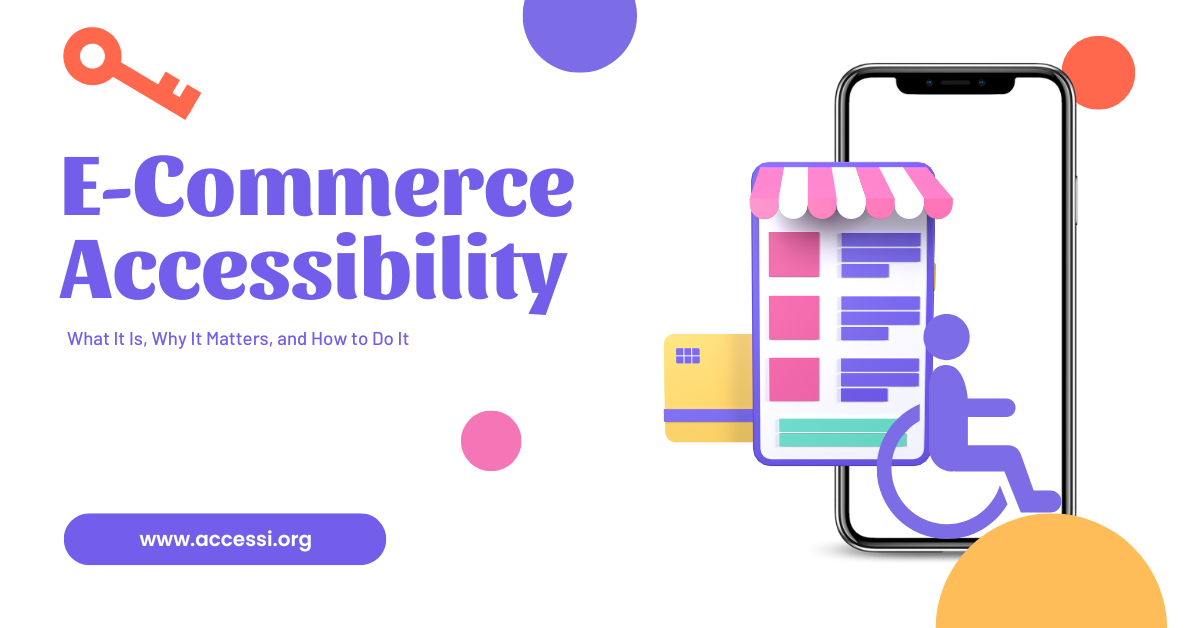E-Commerce Accessibility: What It Is, Why It Matters, and How to Do It

Introduction
The digital marketplace is a bustling hub of activity, where transactions occur at the speed of light. In this fast-paced environment, the concept of web accessibility often takes a backseat, yet it is a critical component that can make or break the user experience. For e-commerce websites, accessibility is not just about enabling transactions; it’s about empowering all users to participate fully in the digital economy.
Accessibility in e-commerce means ensuring that online stores are navigable, understandable, and usable for people with a wide range of disabilities. This includes individuals with visual, auditory, motor, or cognitive impairments who require assistive technologies or alternative ways to interact with web content. By focusing on accessibility, e-commerce platforms can tap into a broader customer base and foster an inclusive shopping environment.
This article will explore the multifaceted aspects of e-commerce accessibility. We’ll delve into its definition, the legal and ethical imperatives driving it, the common challenges faced, and the profound benefits it offers. Additionally, we’ll provide practical guidance on adhering to Web Content Accessibility Guidelines (WCAG), share inspiring case studies, and look ahead to future trends in accessible e-commerce.
Understanding E-Commerce Accessibility

E-commerce accessibility is the practice of making online shopping platforms usable for everyone, including people with disabilities. It’s a crucial aspect of web design that ensures all customers have equal access to products and services. When e-commerce sites are accessible, they not only comply with legal standards but also demonstrate a commitment to inclusivity.
The impact of e-commerce accessibility is profound. For users with disabilities, it means the difference between independence and reliance on others to shop online. For businesses, it represents an opportunity to connect with a wider audience, including the more than one billion people worldwide who live with some form of disability. Ignoring accessibility can result in lost sales and missed opportunities to build loyal customer relationships.
Statistics and real-life examples underscore the importance of accessibility. For instance, a study by the Click-Away Pound survey revealed that in the UK alone, businesses lose out on £17 billion a year due to poor website accessibility. This highlights the economic incentive for e-commerce sites to prioritize accessibility and ensure they are not excluding a significant portion of the market.
Legal and Ethical Considerations
The legal landscape surrounding e-commerce accessibility is becoming increasingly stringent. The Americans with Disabilities Act (ADA) in the United States, along with international regulations like the Equality Act 2010 in the UK and the European Accessibility Act, require digital platforms to be accessible to individuals with disabilities. Non-compliance can lead to costly lawsuits and damage to a company’s reputation.
Beyond legal compliance, there’s an ethical imperative to e-commerce accessibility. It’s about recognizing the dignity and rights of all individuals to participate in the digital marketplace. Ethical business practices demand that we consider the diverse needs of our customers and strive to create an online shopping experience that is welcoming to all.
The ethical approach to e-commerce accessibility also aligns with corporate social responsibility (CSR) initiatives. By making their platforms accessible, businesses demonstrate a commitment to social values and human rights, which can enhance their brand image and foster customer trust and loyalty.
Common Accessibility Challenges in E-Commerce
Navigating an e-commerce site can be a daunting task for individuals with disabilities if the site is not designed with accessibility in mind. Common barriers include complex forms that are difficult to fill out, product images without descriptive alt text, and navigation menus that are not keyboard-friendly. These issues can prevent users from completing purchases, leading to frustration and abandonment of the shopping cart.
For example, a visually impaired user might rely on a screen reader to browse products. If images lack proper alt text, the user may miss out on crucial information, making it impossible to make an informed purchase decision. Similarly, users with motor impairments may struggle with drop-down menus or sliders that require precise mouse control, which can be a significant obstacle to completing a transaction.
Addressing these challenges is not just about removing barriers; it’s about enhancing the user experience for everyone. Accessible design principles, such as clear labeling, logical layout, and consistent navigation, benefit all users by making sites more intuitive and easier to use. This universal design approach leads to a more streamlined and satisfying shopping experience for every customer.
Benefits of E-Commerce Accessibility
The benefits of e-commerce accessibility extend far beyond compliance and ethics. For businesses, accessible websites can lead to increased sales and a wider customer base. Users with disabilities represent a significant market segment, and when they find a site that caters to their needs, they are likely to become repeat customers.
Moreover, accessible e-commerce sites tend to rank higher in search engine results, as search engines favor content that is clear and well-structured. This improved search engine optimization (SEO) can drive more traffic to the site, resulting in greater visibility and potentially more sales. Additionally, accessible sites often have faster load times and lower bounce rates, which can further enhance the user experience and boost conversion rates.
The commitment to accessibility can also enhance a brand’s reputation. Customers appreciate businesses that demonstrate social responsibility and inclusivity. By investing in accessibility, companies can build customer loyalty, differentiate themselves from competitors, and establish themselves as leaders in their industry.
Web Content Accessibility Guidelines (WCAG)
The Web Content Accessibility Guidelines (WCAG) are the gold standard for web accessibility. Developed by the World Wide Web Consortium (W3C), these guidelines provide a framework for making web content more accessible to people with disabilities. The WCAG principles—Perceivable, Operable, Understandable, and Robust (POUR)—are essential for creating an inclusive e-commerce experience.
“Perceivable” means that users must be able to perceive the information being presented; it cannot be invisible to all of their senses. This includes providing text alternatives for non-text content, such as images, and ensuring that audio and video content is accessible. “Operable” ensures that users can operate the interface, which means that the site must be navigable by keyboard and that any interactive elements are easy to use.
“Understandable” requires that information and the operation of the user interface must be understandable. This means that content should be clear and predictable and that it should avoid causing confusion. Finally, “Robust” means that content must be robust enough to be interpreted reliably by a wide variety of user agents, including assistive technologies. This ensures that content remains accessible as technologies evolve.
Does your website comply with WCAG standards? Run free test ➡️
Making E-Commerce Accessible
- Website Structure and Navigation
An accessible website structure and navigation system are the cornerstones of a positive user experience. Clear and consistent navigation helps users understand where they are on the site, how to get back to a previous page, and how to proceed to the next step in their shopping journey. For users with disabilities, this clarity is even more crucial.
Menus, search bars, and filters should be designed with accessibility in mind. This means using proper HTML elements, ensuring keyboard navigability, and providing clear visual indicators of focus. Additionally, the site structure should be logical and hierarchical, with proper use of headings and landmarks to guide users through the content.
- Product Listings and Descriptions
Product listings and descriptions are key components of any e-commerce site. For users with disabilities, these elements must be presented in a way that is accessible and informative. Images should have descriptive alt text that conveys the same information as the visual content. Product descriptions should be detailed and clear, providing all the necessary information for users to make an informed decision.
Best practices for accessible product information include using simple language, providing text descriptions for all visual and audio content, and ensuring that interactive elements are easy to identify and use. This not only benefits users with disabilities but also improves the overall user experience by making product information more digestible for all customers.
- Shopping Carts and Checkout
The shopping cart and checkout process are critical stages in the e-commerce experience. An accessible shopping cart allows users to review their selections easily, make changes, and proceed to checkout without confusion. The checkout process should be straightforward, with forms that are easy to fill out and clear instructions for completing the purchase.
Accessible checkout forms should include properly labeled fields, error messages that are easy to understand, and a logical flow that guides the user through the process. Providing alternative payment methods and ensuring that all steps are navigable by keyboard are also important considerations for accessibility.
- Accessibility Testing
Accessibility testing is an essential part of maintaining an accessible e-commerce site. It involves evaluating the site against the WCAG guidelines and identifying areas where improvements are needed. Tools like automated checkers can help detect technical issues, but manual testing by accessibility experts and users with disabilities is also crucial.
Methods for accessibility testing include using screen readers, keyboard-only navigation, and color contrast analyzers. These tools can help uncover issues that might not be immediately apparent, such as hidden content or interactive elements that are not keyboard-accessible. Regular testing and updates are necessary to ensure that the site remains accessible as technology and content change.
User Testing and Feedback

User testing with individuals who have disabilities is invaluable for understanding the real-world challenges faced by this audience. By involving users in the testing process, businesses can gain insights into how their site is used and where improvements can be made. This feedback is crucial for iterative development and for ensuring that the site meets the needs of all users.
Gathering feedback can be done through surveys, user interviews, and usability testing sessions. It’s important to create an environment where users feel comfortable sharing their experiences and to act on the feedback received. This ongoing dialogue with users helps to refine the accessibility features of the site and to build a more inclusive shopping experience.
E-Commerce Accessibility Case Studies
There are numerous success stories of e-commerce businesses that have prioritized accessibility. These case studies serve as inspiration and proof that investing in accessibility is not only the right thing to do but also good for business. Companies that have implemented accessibility features report not just compliance with legal standards, but also a boost in customer satisfaction and an increase in sales.
One notable example is a major online retailer that redesigned its website to meet WCAG standards. As a result, the company saw a 20% increase in sales from users who utilize assistive technologies. Another case involved an e-commerce platform that introduced video descriptions for its products, which significantly improved the shopping experience for users with visual impairments and led to a higher conversion rate.
These case studies demonstrate that when businesses take proactive steps to remove barriers and ensure their sites are accessible, they open their doors to a wider audience. The positive outcomes extend beyond compliance and contribute to a stronger, more inclusive brand image.
Future Trends and Considerations
The landscape of e-commerce accessibility is ever-evolving, with new technologies and trends continuously emerging. Voice commerce, for instance, is becoming increasingly popular, allowing users to shop online using voice commands. This technology has the potential to make e-commerce even more accessible, particularly for users with visual or motor impairments.
Accessible mobile apps are another area of growth, as more consumers use smartphones and tablets for online shopping. Ensuring that these apps are designed with accessibility in mind is crucial for reaching the widest possible audience. Additionally, advancements in artificial intelligence and machine learning offer promising avenues for automating and improving accessibility features. As these technologies develop, it’s essential for businesses to stay informed and adapt their accessibility strategies accordingly. The commitment to accessibility must be ongoing, with regular updates and improvements to keep pace with the changing digital landscape.
Conclusion
E-commerce accessibility is a journey that requires continuous effort and dedication. It’s about more than just meeting legal requirements; it’s about fostering an inclusive environment where all customers, regardless of their abilities, can enjoy the freedom and convenience of online shopping. By embracing accessibility, businesses can enhance their customer experience, tap into new markets, and build a brand that stands for equality and inclusion.
In conclusion, e-commerce accessibility is not just a good practice—it’s a vital aspect of modern business that can lead to a host of benefits, from legal compliance to increased customer loyalty. As the digital world becomes more integrated into our daily lives, the importance of accessibility will only grow. Businesses that prioritize and invest in accessibility today will be well-positioned to succeed in the inclusive marketplace of tomorrow.
If you found this article helpful, please share it to help spread awareness about the importance of e-commerce accessibility! 🌐
Leave a Reply